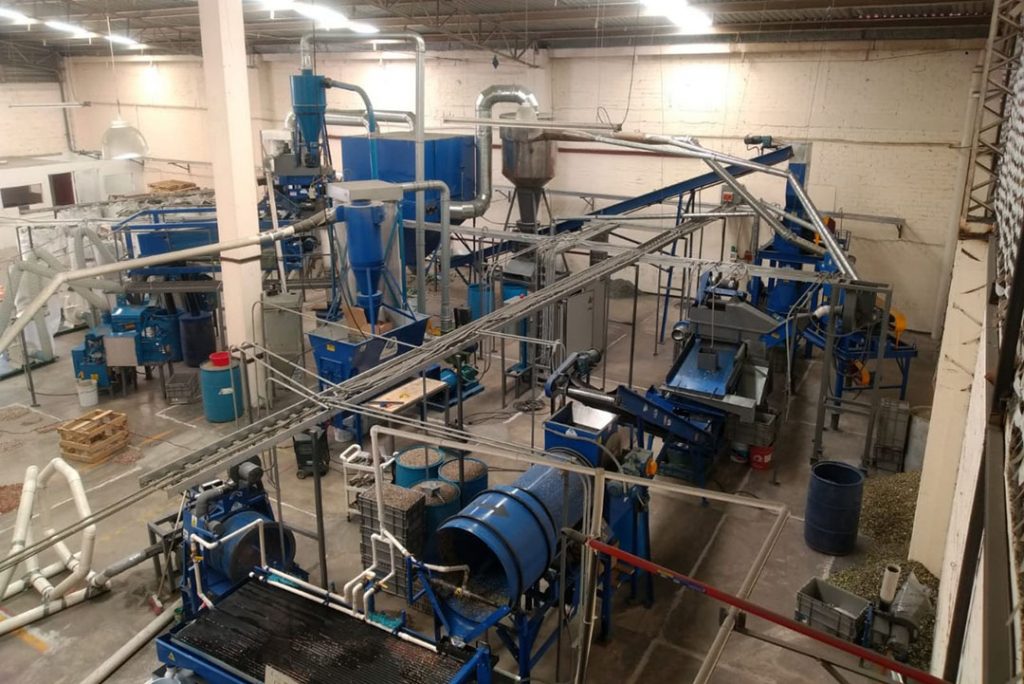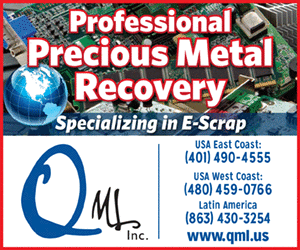 The PCB Scrap Recovery system is designed specifically to process low-grade circuit boards. | Courtesy of PCB Scrap Recovery.
The PCB Scrap Recovery system is designed specifically to process low-grade circuit boards. | Courtesy of PCB Scrap Recovery.
A Mexican engineering firm has developed a printed circuit board processing system marked by low resource use and simplicity. The company recently patented the process and is looking for partners.
Javier Jimenez, a mechanical engineer and founder of PCB Scrap Recovery S.A. de C.V., said his company’s process does not use any fire or chemicals. And it uses inexpensive equipment, omitting shredders and eddy current separators for more basic alternatives.
Those factors – environmental friendliness and low-cost machinery – give the system its advantage in the marketplace, according to Jimenez, who has also worked in the e-scrap collection field.
“This system is a truly ecological process,” he said.
The process takes in circuit boards and processes them into distinct metals-bearing powders that can be sold to downstream processors.
Refining at every stage
“To understand our system, the keyword is refinement,” Jimenez said.
The system brings in low-grade circuit boards and first sends them through a hammermill for size reduction. During this stage, air is directed at the lightest particles, sending them into a baghouse filter.
The larger material that comes out of the hammermill is conveyed to a screen, which separates by size. Larger particles are directed to a second hammermill for further size reduction and conveyed back to the screen.
Particles of the desired size continue on to a magnetic drum, Jimenez explained, to separate out the ferrous metals.
Next, the remaining non-ferrous metals go through another screen, which removes fines and undersized material. Particles of the desired size are conveyed to another screen, where the material is mixed with water.
The moistened particles are conveyed onto a “Wilfley table,” which separates material by density. In Jimenez’s process, this step is used to separate non-metallic components, namely plastics, from metals.
Both streams are dried and the non-ferrous metal stream goes through another milling process for size reduction. These metals are deposited onto a screen that separates them into fine- and medium-sized particles.
Then, in a final sorting step, the remaining metals stream is put through dry separator equipment, which uses gravity to sort similar-size particles by weight. This system uses air directed at the stream at a certain strength to sort the materials, separating the metals and removing any remaining plastics.
“This is the last stage of the process, where copper and aluminum are obtained separately,” Jimenez wrote. At that stage, the system has produced highly pure copper, aluminum and iron segments, as well as the plastics stream.
The metal segments come out of the process in a powder form, where they can be sold to a smelter or intermediate processor to be refined further to separate the powders into more distinct metal categories. For instance, the copper powder might contain tin, silver and other materials that have higher specific weights than copper, Jimenez explained.
Targeting a low-value stream
The PCB Scrap Recovery system is designed specifically to process low-grade circuit boards. Jimenez experienced trouble marketing these materials after he started an e-scrap collection business in 2012.
“Low-grade PCBs are not appreciated by the recycling industry due to the low value of their components,” the company noted in a written description of its technology. “Compared to high-grade electronics, whose components include precious metals, low-grade PCB recycling has been left aside.”
The low-grade boards include metals such as copper, tin, aluminum, iron and others, but lack significant quantities of gold, silver, palladium, platinum and other metals found in higher-grade PCBs.
In 2014, Jimenez put his collection business on pause and began studying the stream closely, taking apart 500 circuit boards and weighing the components to determine whether it was worthwhile to separate the copper, steel and aluminum. He found it would substantially increase the value of the boards and could be economically achieved with affordable equipment.
“The capital investment of the system is considerably smaller compared to other systems developed these days,” according to the company’s description of the technology.
According to the company, the system uses 3.48 horsepower per kilogram processed (about 7.7 horsepower per pound).
More stories about metals
- Company debuts battery-containing device shredder
- Texas A&M researches rare earth extraction
- Bill would create critical minerals task force



